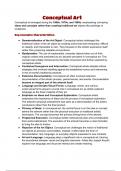Conceptual Art
Conceptual art emerged during the 1960s, 1970s, and 1980s, emphasising conveying
ideas and concepts rather than creating traditional art objects like paintings or
sculptures.
Key concepts/ Characteristics:.
● Dematerialisation of the Art Object: Conceptual artists challenged the
traditional notion of the art object by creating works that were temporary, difficult
to classify, and impossible to own. They focused on the artistic experience itself
rather than producing saleable end products.
● Readymades: The use of readymades, everyday objects taken out of their
original context and presented as art, became prevalent in conceptual art. This
concept was initially introduced by the Dada movement and further explored by
conceptual artists.
● Contextual Insurgence and Intervention: Conceptual artists adopted critical
strategies that involved rebelling against the established norms and intervening
in the art world's traditional practices.
● Extensive Documentation: Conceptual art often involved extensive
documentation of the artistic process, performances, and events. Documentation
became an integral part of the artwork itself.
● Language and Scripto-Visual Forms: Language, words, and various
script-visual forms played a crucial role in conceptual art, as artists explored
language as the basic material of their art.
● Emphasis on Ideas and Conceptual Exploration: Conceptual artists
emphasise the importance of ideas and the process of conceptual exploration.
The artwork's physical embodiment was seen as a demonstration of the artist's
conclusions rather than the final product.
● Primacy of Ideas: In conceptual art, the central focus is on the idea or concept
behind the artwork rather than the physical execution or traditional artistic
techniques. The concept becomes the primary driving force of the artwork.
● Preplanned Execution: Conceptual artists meticulously plan and conceptualize
their works beforehand. The execution of the artwork becomes a mere formality
to bring the idea to fruition.
● Rejection of the Art Object: Conceptual art challenges the notion of traditional
art objects as precious commodities. Instead, it often takes the form of
documentation, text, language, or everyday objects presented in new contexts.
● Art and Language: Language plays a significant role in conceptual art, blurring
the boundaries between visual and linguistic elements. Artists like Joseph Kosuth
explore how language and visual art interact and create meaning.
, ● Questioning Art's Nature and Coherence: Conceptual art challenges the
traditional notions of art, including the idea of the artist's hand, uniqueness of the
art object, and the desire for coherence and narrative consistency.
Comparing Modernism and Post-Modernism in Art:
Modernism: Postmodernism
Emphasizes objective truth and universal intuition. Questions the notion of objectivity or singular
truth.
Values the art object as both an academic piece Challenges the authority of mainstream ideas.
and a commodity.
Celebrates the artist's personal mark-making and Questions fixed and singular meanings in art.
style as a sign of identity.
Focuses on avant-garde, innovation, progress, Focuses on process and ideas over the final
and originality. product.
Embraces eclecticism, variety, inconsistency, and
contradictions.
Jackson Pollock (Modernist Artist): Lawrence Weiner (Post-Modernist Artist):
Pollock's art was considered to embody "objective Weiner questioned the idea of objectivity or
truth" through universal intuitive expression. singular truth in his works.
, His paintings were valued as art objects and He focused on process and ideas, and his art was
gained significant monetary and academic not bound to traditional art objects.
recognition.
He was seen as a creative genius, and his Weiner's art often involved language and text,
distinctive drip painting style became synonymous reflecting the significance of language in
with his identity. conceptual art.
He embraced eclecticism and variety in his
approach to art, and his works explored diverse
concepts and themes.
In summary, conceptual art rejects the traditional art object and places emphasis on conveying ideas and
concepts. It involves the use of readymades, extensive documentation, and a strong link to language and
words. Conceptual artists challenge established norms and value the artistic experience itself over the
creation of saleable end products.
Joseph Kosuth: Art and language
● Use of Language and Concepts: Joseph Kosuth employs language, knowledge,
science, and worldly data as the subject matter of his art. He believes
understanding the linguistic nature of art propositions is fundamental to his work.
He explores how language and visual art interact and how viewers make
meaning by linking visual images with mental concepts.
● Inspiration from Duchamp: Kosuth draws inspiration from Marcel Duchamp's
work, particularly the concept behind the readymade artwork "Fountain."
Duchamp's emphasis on the idea over the physical object greatly influenced
Kosuth's approach to art.
● Questioning the Nature of Art: Kosuth sees it as the artist's role to question the
nature of art itself. He challenges traditional notions of art and pushes the
boundaries of artistic expression by focusing on ideas rather than physical
craftsmanship.
● Art-as-Idea as Idea: Kosuth's approach is often described as "art-as-idea as
idea," where the conceptual framework and the underlying idea take precedence
over the tangible artwork.




